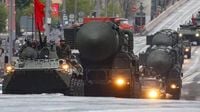In the backdrop of the ongoing conflict in Ukraine, a significant transformation is underway in global military dynamics, particularly regarding the use of ballistic missiles. Once reserved for powerful nations as a last-ditch warning, these weapons are now being deployed regularly across various battlefields, serving as tools of military engagement, political messaging, and international conflict escalation.
The war in Ukraine exemplifies this shift, with Ukrainian forces leveraging U.S.-made ATACMS and U.K.-French Storm Shadow missiles to strike deep into Russian-held territories. These advanced munitions enable Ukrainian troops to target critical supply centers, airfields, and command sites, fundamentally altering Russia's military strategy and response. As a result, Russia has countered with its new Oreshnik missile, a medium-range ballistic missile boasting hypersonic capabilities designed to evade Western missile defenses.
This evolving missile warfare landscape signals a departure from traditional military engagements, where missiles were primarily theoretical deterrents. Now, both Ukraine and Russia are utilizing advanced missiles in ways that blur the lines between conventional warfare and escalatory threats. The psychological impact of these weapons is profound; cities once considered safe are now vulnerable, and previously untouchable facilities have become legitimate targets.
Several key trends from the conflict have emerged, corroborated by the 2020 NASIC threat review. First, missiles are increasingly employed in active combat rather than reserved for extreme situations. Countries are using them to exert pressure and gain tactical advantages. Second, mobility and concealment have become crucial for survival, with missile launchers disguised as civilian vehicles or hidden underground, complicating detection efforts. Third, modern missiles are equipped with sophisticated guidance systems, multiple warheads, and decoys, making them harder to intercept with existing missile defense systems like THAAD, Patriot, or Iron Dome.
Moreover, missile technology is proliferating beyond the control of major military powers. Middle-tier nations and even non-state actors are now gaining access to these weapons, contributing to a more unstable and perilous global environment. The conflict in Ukraine is not merely a localized battle; it serves as a harbinger of future warfare, characterized by rapid, long-range, and precise strikes enabled by advanced technology.
In addition to the developments in Ukraine, the Middle East has witnessed a similar trend. Iran's backing of proxy groups such as Hezbollah and the Houthis has led to the creation of substantial missile arsenals that pose significant threats to regional powers like Israel and Gulf states. In 2023, missile strikes from Gaza and southern Lebanon strained Israel's Iron Dome defense system, while the Houthis targeted oil facilities in Saudi Arabia and the UAE, showcasing the economic vulnerabilities inherent in this new form of warfare.
The regularization of ballistic missile use across various conflicts has serious implications for international peace and security. Firstly, it undermines existing arms control frameworks. Treaties like the New START Treaty fail to address emerging missile types, including hypersonic weapons and advanced systems like the Oreshnik. The Missile Technology Control Regime (MTCR) lacks robust mechanisms to regulate non-state actors, and no global agreement effectively limits the deployment of precision-guided conventional missiles.
Secondly, this shift is fueling regional arms races. In response to escalating tensions, countries such as Poland, Finland, and Japan are investing in missile capabilities. Concurrently, the U.S. and its allies are accelerating the development of advanced defense technologies, including laser systems and AI-driven early warning satellites.
Furthermore, the increased prevalence of missile strikes raises the risk of misinterpretations and rapid escalations. A single missile launch could be perceived as a significant threat, and the failure of missile defenses could leave nations with little time to respond diplomatically, potentially igniting broader conflicts.
As the landscape of warfare evolves, the implications of missile proliferation are profound. Ukraine has demonstrated that precision-guided missiles can achieve military objectives that previously required air superiority or nuclear deterrence. Russia's deployment of the Oreshnik missile serves not only as a tactical response but also as a strategic signal to NATO and the West of its ongoing military capabilities.
This new reality presents two critical challenges. First, international institutions must reassess how they monitor and control missile proliferation to prevent crises. Second, military defenses must be enhanced to counter both large-scale missile assaults and targeted strikes aimed at critical infrastructure.
While the previous century was dominated by the specter of nuclear annihilation, the current era may be defined by the rapid spread of accurate and high-velocity missiles that can be deployed with increasing frequency. Without effective diplomatic strategies and international cooperation, future conflicts may not be averted through fear but rather ignited by confidence in the ability to strike first.
In parallel, modern warfare is also being reshaped by the rise of drones and artificial intelligence (AI). Unmanned aerial vehicles (UAVs) are becoming ubiquitous in conflicts worldwide, offering capabilities that often exceed their costs. This transformation has raised concerns across Europe, particularly as NATO countries observe the rapid advancements made by Russian and Ukrainian forces in drone technology.
President Putin announced that the Russian military acquired 140,000 UAVs in 2023, with production increasing nearly tenfold to 1.4 million drones in 2024. This massive expansion provides Russia with a formidable swarming capability, a lesson that European nations cannot afford to ignore as they seek to bolster their own drone production.
The integration of drones into military operations allows for lethal precision without risking personnel, making them highly effective in asymmetric warfare. As AI technology continues to develop, the accuracy and success rates of drone strikes are expected to improve significantly.
In conclusion, the ongoing conflicts in Ukraine and the Middle East are not isolated incidents but rather reflections of a broader transformation in military strategy. The rise of missiles and drones signifies a shift toward more dynamic and complex warfare, necessitating urgent adaptations in defense strategies and international cooperation to mitigate the risks posed by these evolving threats.


